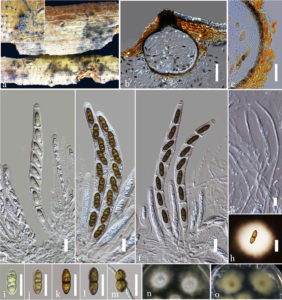Castellaniomyces rosae Senan., Camporesi & K.D. Hyde, in Hyde et al., Fungal Diversity 87: 183 (2017)
Index Fungorum number: IF 553638, Facesoffungi number: FoF 03564
Etymology – name referring to the host genus on which the fungus occurs.
Holotype – MFLU 15-0720
Saprobic on branch of Rosa sp. Sexual morph: Appearing as slightly raised, black ostiolar dots on the host surface, surrounded black patches, the pseudostromata. Pseudostromata made up of host cells and brown to black fungal hyphae, comprising a wide, darkened layer around the ostiole and a thin, darkened hyphal layer beneath the cuticle, spreading across the host surface and forming the darkened region above the ascomata. Ascomata 275–325 μm high, 270–275 μm diameter (x̅= 305 × 274 μm, n = 20), scattered, solitary or clustered in darkened regions, immersed, globose to subglobose, dark brown, ostiolate. Ostiole short, narrow, conical, periphysate, surrounded by a darkened, slightly raised, conical region. Periphyses hyaline, filamentous. Peridium 7–14 μm wide (x̅ = 10 μm, n = 20) thin, two-layered, outer layer comprising 3–5 layers of dark brown cells arranged in a textura angularis and inner layer comprising 2–4 layers of thin-walled, hyaline cells. Hamathecium comprising numerous, 2–3.5 μm (x̅ = 2.8 μm, n = 20) wide, filamentous, septate, hyaline, slightly tapering paraphyses. Asci 162–200 × 14–17 μm (x̅ = 180 × 15.5 μm, n = 20), 8-spored, unitunicate, cylindrical, base attached to the centrum by a short, indistinctly pedicel, apex rounded, with a cylindrical, J-, apical ring. Ascospores 19–22 × 5.5–7 μm (x̅ = 20 × 6 μm, n = 20), uniseriate to overlapping uniseriate, oval to fusiform, 1-median septate, constricted at the septum, hyaline when young and becoming light brown, then dark brown when mature, minutely verruculose, with thick, mucilaginous sheath, visible in ascus as compartments, and spreading when released from ascus. Asexual morph: Undetermined.
Culture characteristics – Cultures growing on MEA reaching 1 cm after 10 days at 18 C, circular, slightly raised, with filamentous margin, centre of colony white, woolly, with sparse aerial mycelium and margins with hyaline, unbranched mycelium.
Material examined – Italy, Province of Forlı`-Cesena [FC], near Castrocaro Terme, on the dead aerial branch of Rosa canina L. (Rosaceae), 18 December 2013, E. Camporesi, IT 1582 (MFLU 15-0720, holotype); ibid, ex-type living culture MFLUCC 15-0536.
GenBank accession numbers – ITS: MF614127; LSU: MF614130.
Notes – Castellaniomyces is introduced and typified by C. rosae. Combined gene analysis of ITS, LSU, RPB2, and beta-tubulin shows that Castellaniomyces clusters sister to Barrmaelia with a moderate support value. However, Castellaniomyces differs from Barrmaelia in having elongated fusiform, uniseptate ascospores with a thick mucilaginous sheath and asci with a J-, apical ring.

Fig 1. Castellaniomyces rosae (MFLU 15-0720, holotype). a Pseudostromata on substrate. b Cross section of immersed ascoma. c Peridium. d, f Asci in Melzer’s reagent with J-, apical ring. e Asci in water. g Paraphyses. h Ascospore in Indian ink with sheath. i-l Ascospores. m Germinating ascospore. n Surface view of culture on MEA. o Reverse view of culture on MEA. Scale bars: a = 500 μm, b, d-k = 50 μm, c, h = 10 μm, g = 20 μm.
